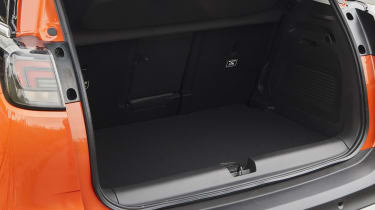Vauxhall Crossland SUV - Practicality & boot space
Little criticism here: the Vauxhall Crossland is spacious and has a decent boot
In terms of metal for your money, the Vauxhall Crossland is decent value. While it’s based on the same mechanical platform as the last-generation Peugeot 2008, it’s actually longer, taller and wider than this car. It’s not until you get to cars from ostensibly the class above like the Nissan Qashqai that you find larger measurements are the norm.
Vauxhall Crossland: interior space & storage
It’s all too easy to take sound ergonomics for granted, but the Crossland deserves some recognition in this area. The central armrest is perfectly placed so your hand lines up with the gearlever, while the driver’s side door armrest is equally well-judged and provides a natural angle for your elbow to rest on during a long cruise; the story’s the same with the pedals and steering wheel, although the foot rest next to the clutch could be larger and drivers with big feet may wish for a little more space.
Other plus points include excellent seats (they could do with a bit more lumbar support but left us rested after a long drive) and well placed major switches for the infotainment system, windscreen wipers and other controls – the Crossland is a straightforward car to get to know. Two accessible, well-sized cupholders rest in the central console, and the door bins are big enough. However, we feel the glovebox is smaller than it should be.
More reviews
In-depth reviews
There's more room inside the Crossland’s cabin than some cars from the class above. Knee room in the rear is generous, and the headroom plentiful. However, it should be pointed out that while this sense of spaciousness will appeal to some, the eight or so inches of space above front-seat occupants' heads is essentially wasted. The tall roof that provides this has a negative effect on the way the Crossland drives.
There are also a couple of ergonomic niggles worth pointing out: the release button for the handbrake sits on top of it rather than on its end, which is an unnecessary modification that adds nothing but frustration. Similarly, the selection knob for the trip computer is on the indicator stalk. It requires you to twist not the end of the stalk but a ring in the middle of it – a fiddly manoeuvre on the move. We only mention these minor details as blemishes on an otherwise ergonomically excellent car.
Unlike the old Crossland, a 60:40 folding rear seat is now standard on the facelifted Crossland making it more practical.
Boot space
At 410 litres, the Crossland's boot is slightly bigger than the SEAT Arona's but notably smaller than the one in the latest Renault Captur. It's very well shaped, though, offering an almost perfectly rectangular loading bay and virtually no lip. If you have the optional sliding rear seats, moving these forward sees space increase to 520 litres, while if you drop them, the figure grows to 1,255; they don't lie flat when folded, though.
Towing
The Vauxhall Crossland probably won't be on your shortlist if you're planning to tow anything besides a small trailer. Most models can tow a mere 840kg braked trailer, and the non-turbo 1.2-litre petrol is only rated for 650kg.










